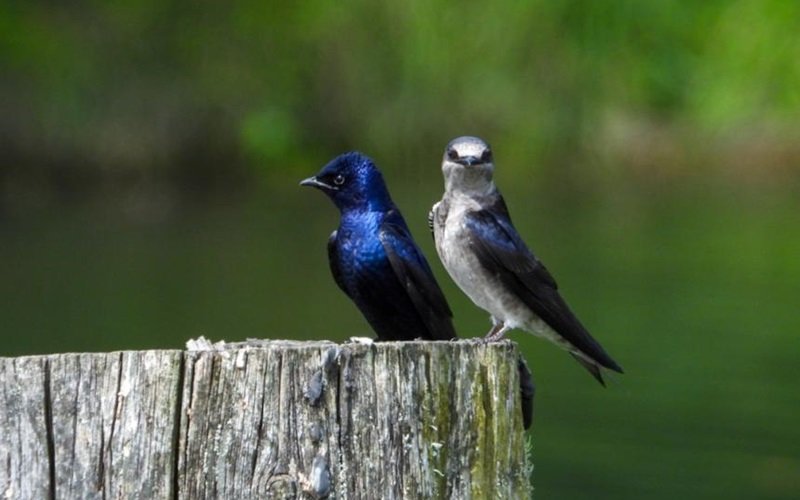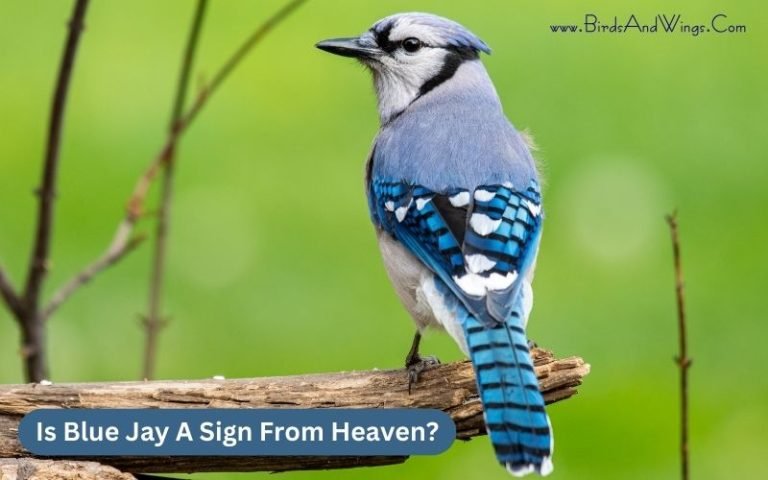Top 13 Purple Birds Species (A List With Information)
Birds have a diverse color pattern over their body. Among those vibrant, colorful plumages, the purple color stands out the most as a pure sign of the beauty of avian species along with their captivating features.
These features attract humans, bird watchers, and bird enthusiasts. This article will explore the top 13 purple bird species in detail, including their scientific names, size, wingspan, lifespans, native places, food habits, and other facts.
Top 13 Purple Birds Species (A List With Information)
This section will provide 13 purple birds’ characteristics such as scientific names, native places, diets, size, wingspan, and lifespans.
It will also discuss their physical description, distribution, habitats, breeding and nesting habits, behavior, and other qualities in detail.
Bird 1: Purple Martin

- Scientific name: Progne subis
- Lifespan: 13 years in the wild
- Wingspan: 15.3–16.1 in (39–41 cm)
- Native to: North America
- Size: 7.5–7.9 in (19–20 cm)
- Food or Diet: insects, mosquitoes, ants, etc
Purple Martin birds are passerine songbirds related to the swallow family. Their bodies are bluish-deep purple with light underparts.
These species are local to North America, including Mexico and British Columbia. Their breeding ranges are Central Alberta, the Eastern United States, California, Arizona, and New Mexico.
They build their nests in cavities or artificially structured nests by humans. Certainly, humans put artificial boxes, hollow grounds, or houses in many places.
Martin birds prefer these places for their nesting sites. These purple birds are quite vocal as they like to use vocal sounds like chirp, chortle, rattle, and croak sounds.
Male Marti reach the breeding sites before the female birds and establish their territory during their breeding seasons. When female birds come they form a pair inside their cavities or artificial nests.
Later, female martins lay one egg within a day and incubate the egg for about 15 to 16 days. These birds can also fly higher and are known for their speed and agility.
Bird 2: Purple Honeycreeper

- Scientific name: Cyanerpes caeruleus
- Lifespan: 17 years
- Wingspan: 54.0 (51.5-57.6) mm
- Native to: Northern South America
- Size: 4.5 in (11.5 cm)
- Food or Diet: insects, spiders, arthropods, small fruits, berries, seeds and nectar
Purple honeycreeper birds are small members of the tanager family Thraupidae. They have a long black, curved bill slightly pointed downward, purple wings, a tail, a belly, and bright yellow legs.
Their weights are approximately 12 grams. They are mostly familiar in Northern South America, including the Amazon Basin and Guianas, the West of the Andes, and southern Panama.
They are also known for the tropical New World, Colombia, Brazil, and Trinidad. These purple martins can fly around 7500 ft high in the sky, and in the lowlands, they can fly around 3300 ft high.
They are generally found in small, minimal groups searching for nectar from flowers and their foods. Their notorious calls can help them guess their predators’ surroundings, such as owls.
Female birds construct their nests in a cup of a tree and incubate the eggs.
Bird 3: Purple-breasted Cotinga

- Scientific name: Cotinga cotinga
- Lifespan: up to 15 years
- Wingspan: not found
- Native to: South America
- Size: 18 cm
- Food or Diet: fruits and insects
Purple-breasted cotinga birds are the subspecies of Cotingdae. Their upper body is bluish purple, and their breasts are purple, with short tails.
These purple-breasted cotingas are found in South America, including Brazil, Colombia, France, Guiana, Guyana, Peru, Suriname, and Venezuela. They prefer tropical moist lowland forests for their habitats.
This species’ favorite diet is fruit. They also eat small insects like ants, bees, butterflies, leafhoppers, and grasshoppers. These birds use their purple color to camouflage themselves.
It helps them to identify or hide from any potential predators.
Bird 4: Varied Bunting

- Scientific name: Passerina versicolor
- Lifespan: Not found
- Wingspan: 21 cm ( 8.3 inch)
- Native to: Southernmost United States, Central America, Northern South America
- Size: 11 to 14 cm ( 4.5-5.5 in)
- Food or Diet: insects, seeds, seed pods, and cactus fruits
Varied Bunting birds are a similar species of songbirds and they belong to the cardinal family. These species are generally common in the Southern parts of Arizona, New Mexico, Texas, and the United States.
Their bills are rounded, and their tails are short. Adult male Buntings or breeding males are purplish red, with a bright red patch on their Nape, which gradually becomes brown during the fall seasons.
Female buntings are brown in color, resembling indigo-bunting female birds. These species of bunting birds prefer deserts and xeric shrublands, thorny brush thickets, thorn forests, and scrubby woodlands for their habitats.
They build open cup nests of grass near watery places. Female Bunting birds lay 2-5 eggs and incubate for 14 days.
Generally, 10 days later, the young are covered with full feathers and leave the nests a few days later.
Bird 5: Purple Starling

- Scientific name: Lamprotornis purpureus
- Lifespan: around 20 years
- Wingspan: not found
- Native to: Africa ( Sub-Saharan places)
- Size: 22-23 cm
- Food or Diet: fruits, berries, and insects
Purple starling birds are also known as purple glossy starling because of their glossy purple plumage over their body. They have metallic green wings over their glossy bodies.
Their tails are short, and they have yellow eyes. Both male and female starlings are almost similar, except that females have a slightly duller, grey underpart and brown Irish.
These species are common in Africa, including Senegal, North Zaire, east to Sudan, and west to Kenya. They also prefer woodlands, cultivation areas for their habitats.
These purple starlings are quite noisy, as they like to chatter. They build their nests in a hole. Female starlings lay two eggs there and incubate them alone.
These purple starling birds are omnivorous, as they can digest tree plants and animal flesh, such as insects and bees.
Bird 6: Violet Sabrewing

- Scientific name: Campylopterus hemileucurus
- Lifespan: around 3 to 5 years
- Wingspan: 82.6 mm (3.25 in)
- Native to: Central America, Mexico to Panama
- Size: 13 to 15 cm
- Food or Diet: flowers, plants, nectar, insects
Violet brewing birds are a similar species of hummingbirds. These bird’s nape, upper portion, face, and underpart are metallic Violet blue, and the belly parts are slightly bluer than purple.
The lower parts of their backs and tails are metallic and shiny green. These species are familiar in Mexico, Guerrero, Veracruz, South Guatemala, southern Belize, Costa Rica, and western Panama.
They prefer evergreen montane forests, mature secondary forests, banana plantations, and gardens as their habitats. These Sabrewing birds can fly 500 to 2000 m (1600-6,600 ft) in the sky.
Their suitable breeding seasons are mostly rainy, around June and September in Mexico. Male brewing birds perform courtship performances by singing among groups of other males and showing their competitiveness to each other.
They build their nests with spiderwebs and fine fibers about 1 to 6 m (3 to 20 ft ) above the ground. Female birds lay two eggs and incubate for 19 to 22 days.
Later the young leave their nests around 22 to 24 days after hatching.
Bird 7: Violet-backed Starling

- Scientific name: Cinnyricinclus leucogaster
- Lifespan: around four years
- Wingspan: not found
- Native to: Sub-Saharan Africa
- Size: 18 cm (7 inches)
- Food or Diet: fruits, seeds, and arthropods
Violet-backed starling birds, also referred to as plum-colored starling or amethyst starling birds, belong to a starling bird family. These birds have violet heads and backs with white lower parts.
They have yellow Irish black bills and black legs. They are mostly familiar with Africa’s sub-Saharan areas.
They are fond of dense rainforest areas, woodlands, gallery forests, and forest verges of the southwestern parts of their habitats. These violent backed starlings can fly up to 21000 m or 6900 ft above in the sky.
They build their nests in a tree a few meters above the ground, using leaves and dunes. Female starlings lay 2 to 4 pale blue, reddish, or brown eggs, which they incubate for 12 to 14 days.
The young leave their nests around 21 days after being hatched.
Bird 8: Blacked-Capped Kingfisher

- Scientific name: Halcyon pileata
- Lifespan: not found
- Wingspan: not found
- Native to: Asia
- Size: 28 cm (11 inches)
- Food or Diet: fish and insects
Black-capped Kingfishers are tree kingfishers, mostly found in Asian continents, including India, China, Korea, Thailand, Sri Lanka, Bangladesh, the Philippines, and Burma. Adult Kingfishers have purple-blue wings and backs.
Their heads and shoulders are black, and their necks are white. Their beaks and legs are coral red. These species generally prefer coastal watery areas like mangroves for their habitats.
They produce ki-ki-ki sounds to communicate with other fellow mates. They continuously perch and dive in order to catch fish. They can also eat large insects.
Their breeding season starts in summer, and they make nests in tunnels on an earth bank. Females lay 4 to 5 white eggs and incubate for several days until they hatch.
Bird 9: American Purple Gallinule

- Scientific name: Porphyrio martinicus
- Lifespan: 22 years
- Wingspan: 50-55 cm
- Native to: United States
- Size: 25-37 cm (10-15 in)
- Food or Diet: flowers, seeds, tubers, spiders, bees, mollusks, beetles, frogs, small fish, and eggs of their birds
American purple gallinules are also known as yellow-legged gallinules because of their bright yellow legs. Apart from their bright yellow legs, adult gallinules have purple-blue plumage with a shiny green base.
Immature purple gallinules have purple features over their chests and red-yellow beaks with a pale blue forehead. Their yellow legs are strong enough that they can walk on floating plants or vegetation.
Although they fly for a short distance, their long legs hang down there when they fly. These purple gallinules are common in southwestern states of the U.S., Florida, Mexico, and Central America during their breeding season.
During their non-breeding seasons, they can be seen in more island areas of Central America. These gallinule birds prefer fresh marshes with dense areas for their habitats.
As they are mostly ground feeders, their maximum diet is from the ground, including plants, insects, frogs, beetles, spiders, earthworms, and fish.
Bird 10: Costa’s Hummingbird

- Scientific name: Calypte costae
- Lifespan: 5 to 8 years
- Wingspan: 11 cm
- Native to: United States, Mexico
- Size: 3–3.5 in (7.6–8.9 cm)
- Food or Diet: nectar from flowers, and insects
Costa’s hummingbirds are a species similar to the hummingbird family. The male hummingbirds have a green back, small tails, and wings. Their heads and throats are a vibrant purple.
Female hummingbirds have mostly grayish-green plumage over their bodies. These species can be found in the United States and Mexico.
Their breeding distributions are in the southwestern United States and northwest Mexico. Later, these birds migrate to western Mexico during the winter season.
Female hummingbirds build their nests with fiber plants and spiderwebs. Females lay two eggs in their nests and incubate for 15 to 18 days until the eggs hatch. Later, the young leave their nest when they are only 20 to 23 days older.
Bird 11: Crowned Woodnymph

- Scientific name: Thalurania colombica
- Lifespan: not found
- Wingspan: not found
- Native to: Belize, Guatemala, and Peru
- Size: 9.5 to 11.5 cm (3.7 to 4.5 in)
- Food or Diet: nectar from flowers and plants
The crowned woodnymph is also referred to as Violet-crowned woodnymph. They have metallic purple greenish plumage on their forehead and upper portion of the body with a shiny metallic green plumage on their throats to chests.
Their belly and shoulders have blue plumage with long bills. These species are almost familiar in Belize and Guatemala, as well as in northern Peru, Colombia, Panama, and Ecuador.
These birds prefer primary and secondary forests, including semi-open landscapes like gardens, coffee, and cacao plantations for their habitats. These species can fly up to 3000 to 3900 ft above sea level.
Their breeding seasons change from region to region. In Costa Rica, they breed between February and June, in Panama in March, and in Colombia from February to September.
Female birds generally build their nests 20ft above the ground. Here, the female bird lays 2 eggs.
Bird 12: Lilac-Breasted Roller

- Scientific name: Coracias caudatus
- Lifespan: around 10 years
- Wingspan: 50 to 58 cm
- Native to: Southern and Eastern Africa
- Size: 36-38 cm
- Food or Diet: small vertebrates, insects, spiders, scorpions, centipedes, snails and small birds
The Lilac-breasted roller birds, small American birds related to the roller family, are widely spotted in Southern Africa and Eastern America.
They are fond of scattered trees, shrubs, open savanna areas, and grasslands for their habitats. Their faces, throats, and chests are purple or lilac, and their upper parts are a mixture of brownish, green, and blue plumage with long tails.
Both male and female rollers are committed to one partner for life and very protective of their nests. Their breeding season starts in April and ends in mid-September.
These birds build their nests around 16 feet above the ground. Female lilac-breasted rollers lay 3 to 4 eggs per breeding season.
Both male and female rollers exchange their incubation period from time to time and incubate the egg for 22 to 24 days.
Bird 13: Purple-Crowned Fairywren

- Scientific name: Malurus coronatus
- Lifespan: around 12 years
- Wingspan: 16 cm (6.3 in)
- Native to: Australia
- Size: 14 cm (5.5 in)
- Food or Diet: invertebrates such as beetles, ants, bugs, grasshoppers, spiders, worms, and little seeds
Purple-crowned fairywren birds are related to the Australasian wren family and are local to northern Australia. Their upper bodies are brown, with blue tails, black bills, and brownish-gray legs and feet, and their lower parts are white, along with purple patches on the head.
Their breeding season is generally from early March to May and late August to November. They prefer to repeat the same site for several years.
Female wrens build small dome-shaped nests with rootless grass, leaves, and barks. Female birds lay 2 to 3 eggs in the nests and incubate for 14 days. After 10 days, the chicks fled.
However, chicks cannot fly, so they stay within the nest and are fed by their mother for another three weeks.
Conclusion
In conclusion, the top 13 purple birds mentioned in this article symbolize beauty and vibrant plumage in avian species.
They mesmerize people or bird watchers with their enchanting beauty and attract humans to explore more about their extraordinary biodiversity.
There have been a lot of birds with diverse qualities, like birds with blue eyes, speckled breasts, or orange breasts, representing their unique biodiversity on earth.







